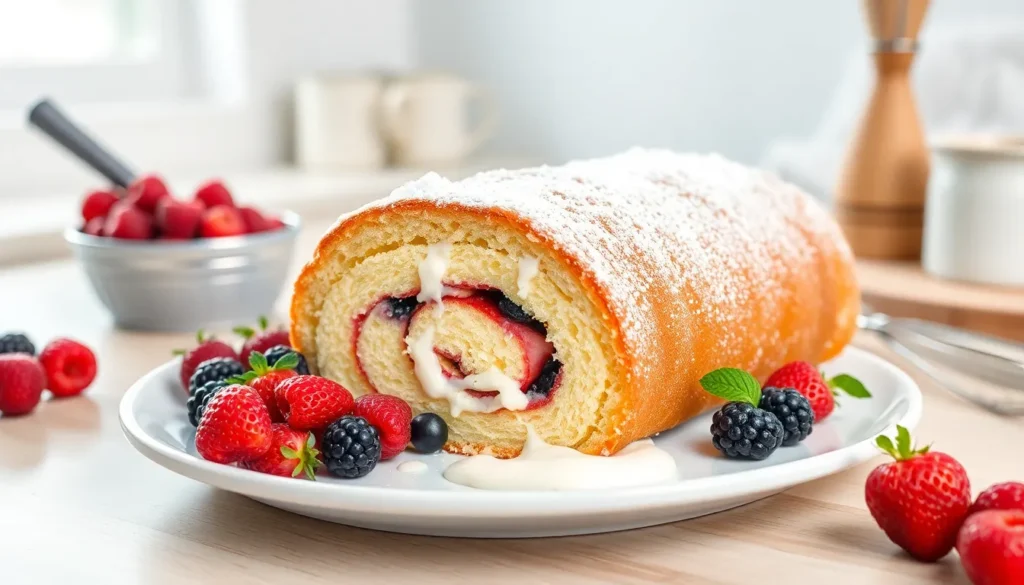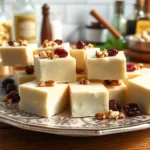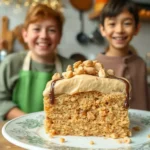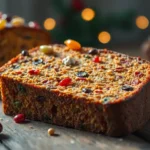We’ve all admired those picture-perfect Swiss roll cakes in bakery windows but assumed they were too complicated to make at home. The truth is vanilla Swiss roll cake is surprisingly achievable with the right technique and a little patience. This classic European dessert combines a light sponge cake with creamy vanilla filling rolled into an elegant spiral that’s guaranteed to impress your guests.
Swiss roll cake originated in Central Europe and has become a beloved dessert worldwide thanks to its versatility and stunning presentation. The key to success lies in creating a tender cake that won’t crack when rolled and timing the rolling process perfectly while the cake is still warm and pliable.
We’ll guide you through each step to create a bakery-quality vanilla Swiss roll that’s fluffy moist and filled with rich vanilla cream. Once you master this fundamental technique you’ll be able to experiment with different flavors and fillings to create your own signature variations.
Ingredients
Success in creating the perfect vanilla Swiss roll starts with gathering fresh quality ingredients. We carefully balance each component to achieve the tender sponge and luscious filling that makes this dessert irresistible.
For the Sponge Cake
- 4 large eggs, room temperature
- 1/2 cup granulated sugar
- 1/2 cup all-purpose flour, sifted
- 1 teaspoon vanilla extract
- 1/4 teaspoon salt
- 2 tablespoons unsalted butter, melted and cooled slightly
For the Vanilla Filling
- 1 cup heavy whipping cream, cold
- 1/4 cup powdered sugar
- 1 teaspoon vanilla extract
- 8 oz cream cheese, softened
- 2 tablespoons unsalted butter, softened
For Optional Dusting
- 2 tablespoons powdered sugar
- 1 tablespoon cocoa powder (for decorative contrast)
Equipment Needed
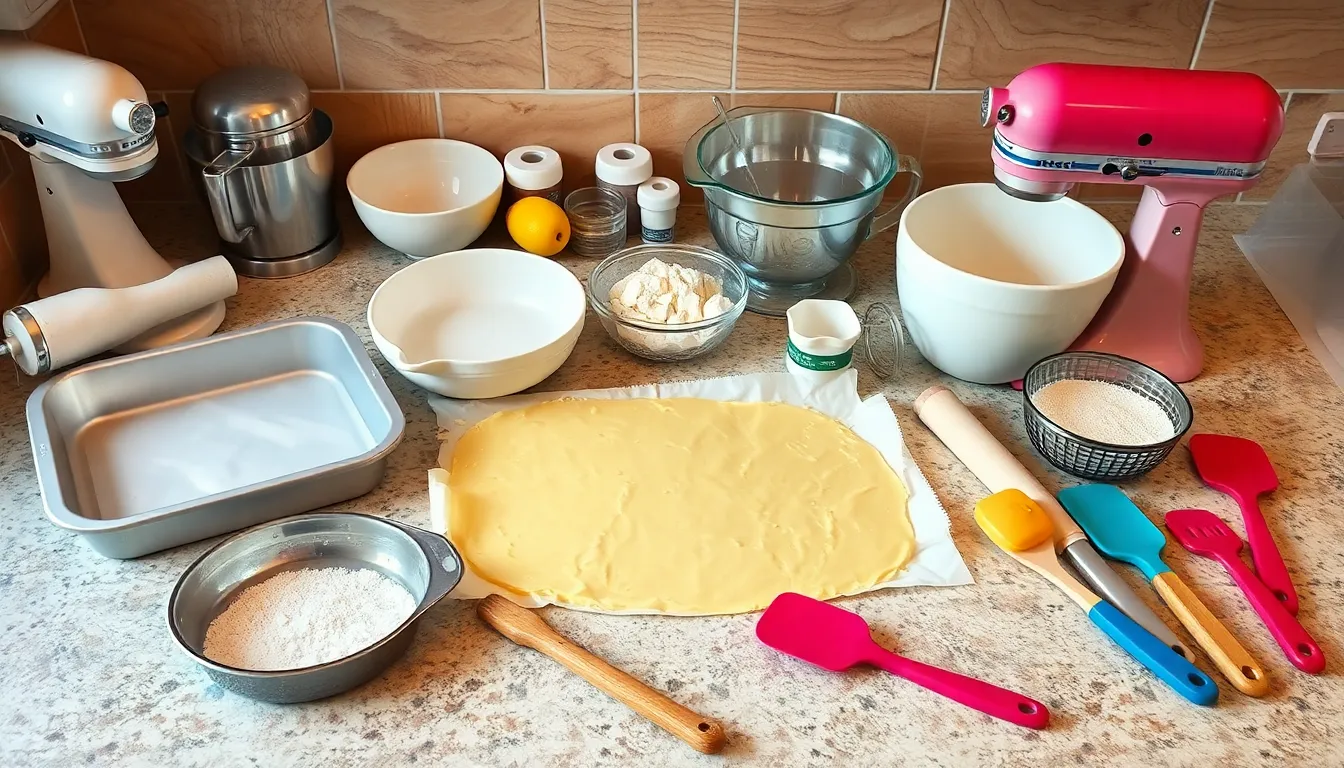
Success with our vanilla Swiss roll cake depends heavily on having the right tools in our kitchen. We need exact equipment to create that signature thin sponge that rolls beautifully without cracking.
Essential Baking Equipment
Our most important tool is a jelly roll pan, with the 10×15-inch or 15×10-inch sizes being the standard options. This specialized pan creates the perfect thin layer necessary for rolling without breaking. We can substitute a 9×13-inch or 13×18-inch cookie sheet if needed, though the cake thickness may vary slightly.
Parchment paper serves as our insurance policy against sticking and tearing. We line our pan completely, allowing some overhang for easy removal. A clean kitchen towel works as an alternative and actually helps during the rolling process.
Mixing and Preparation Tools
An electric mixer becomes absolutely essential for achieving maximum volume when whipping our eggs and sugar. We can use either a handheld or stand mixer, both work equally well for creating that light and fluffy texture our sponge requires.
Our mixing setup includes large mixing bowls for combining ingredients and a small mixing bowl for preparing fillings separately. A sifter ensures our flour stays lump-free and properly aerated, contributing to the cake’s delicate texture.
Finishing Tools
We rely on a rubber spatula for gentle folding motions that preserve the air we’ve whipped into our batter. An offset spatula spreads both batter and filling evenly, ensuring professional-looking results.
A whisk handles thorough ingredient mixing, while an optional tea towel helps us roll the warm sponge to set its shape. Some recipes may require a medium sauce pan for warming ingredients through double boiling.
| Equipment Category | Essential Items | Optional Alternatives |
|---|---|---|
| Baking Pan | 10×15-inch jelly roll pan | 9×13-inch cookie sheet |
| Mixing Tools | Electric mixer, large bowls | Hand whisk (more effort) |
| Preparation | Parchment paper, sifter | Kitchen towel, fine mesh strainer |
| Finishing | Rubber spatula, offset spatula | Regular spatula |
Temperature and Timing Considerations
We achieve best results when our eggs reach room temperature before mixing, as this creates superior volume when whipped. Our finished cake requires several hours of chilling time before we slice it, so we plan accordingly for serving.
Instructions
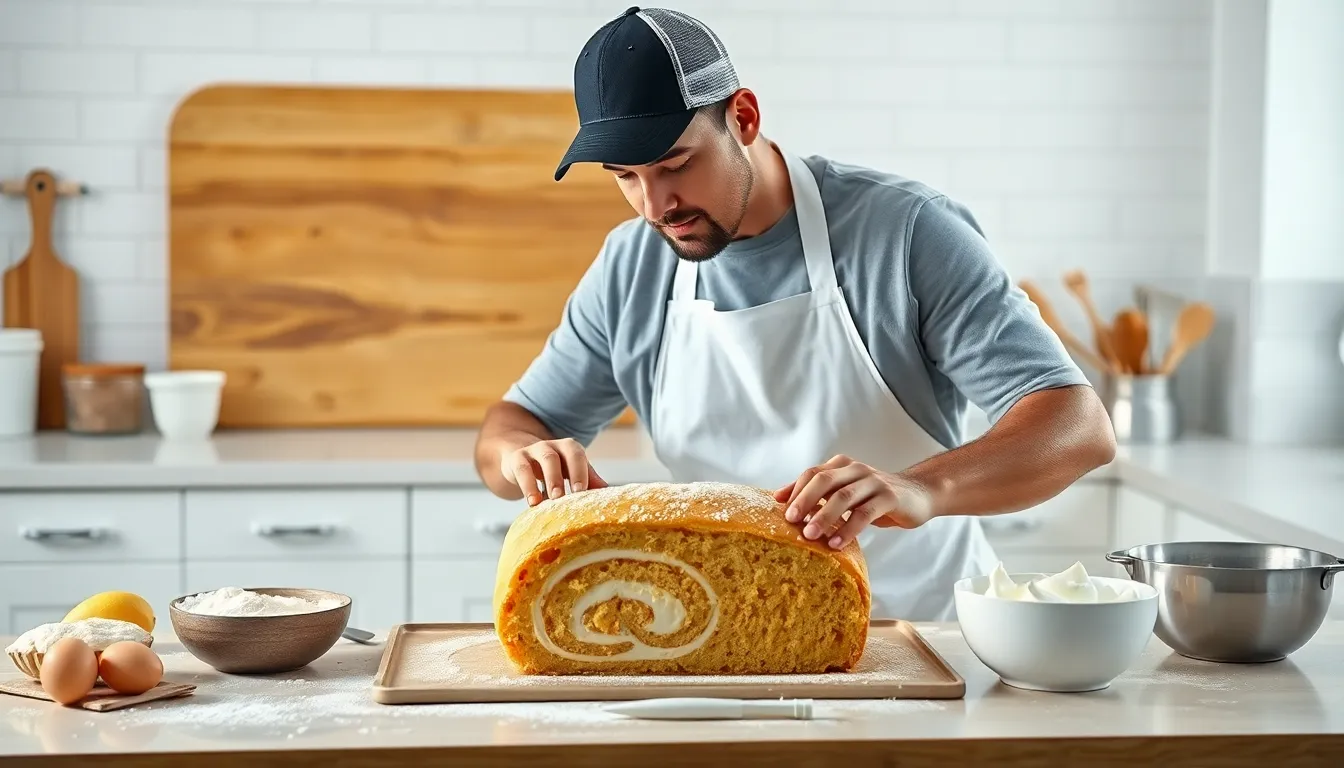
We’ll walk through each step of creating this beautiful vanilla Swiss roll cake with precision and care. Follow these detailed instructions to achieve a perfectly rolled cake with a smooth vanilla filling.
Preparing the Pan and Oven
We begin by preheating our oven to 340°F (170°C) with the fan on or 360°F (180°C) without fan. Butter a 15×10-inch jelly roll pan thoroughly to prevent sticking. Line the pan with parchment paper and lightly butter the parchment as well. This double layer of protection ensures our delicate sponge releases cleanly from the pan.
Making the Sponge Cake Batter
We start with our dry ingredients by sifting 1/2 cup all-purpose flour and 1/4 teaspoon salt into a bowl. Separate 4 large eggs carefully, placing yolks in a large mixing bowl and whites in another clean bowl. Beat the egg yolks with 1/4 cup granulated sugar until the mixture becomes thick and pale. Add 1 teaspoon vanilla extract and mix until combined.
Pour 2 tablespoons melted unsalted butter into the yolk mixture and stir gently. Using an electric mixer, whip the egg whites until soft peaks form, then gradually add the remaining 1/4 cup granulated sugar. Continue beating until stiff peaks form. Fold one-third of the egg whites into the yolk mixture to lighten it. Sift the flour mixture over the batter and fold in gently. Add the remaining egg whites in two additions, folding carefully to maintain the airy texture.
Baking the Cake
Spread the batter evenly in our prepared pan using an offset spatula. Bake for 12-15 minutes until the cake springs back when lightly touched and is golden brown. The cake should not be overbaked as this makes rolling difficult. Remove from the oven and let cool for 2-3 minutes while we prepare for rolling.
Preparing the Vanilla Filling
Beat 1 cup cold heavy whipping cream with 1/4 cup powdered sugar and 1 teaspoon vanilla extract until soft peaks form. In a separate bowl, beat 8 oz softened cream cheese with 2 tablespoons softened unsalted butter until smooth and fluffy. Gently fold the whipped cream into the cream cheese mixture until well combined. Refrigerate the filling while we work with the cake.
Rolling the Cake
Dust a clean kitchen towel generously with powdered sugar. Turn the warm cake onto the towel and carefully peel away the parchment paper. Starting from the short end, roll the cake tightly with the towel inside. Place the rolled cake seam-side down on a wire rack and let it cool completely for about 30 minutes. This step creates the cake’s memory for rolling and prevents cracking.
Final Assembly and Chilling
Unroll the cooled cake gently and remove the towel. Spread the vanilla filling evenly over the surface, leaving a 1/2-inch border on all sides. Roll the cake again, this time without the towel, starting from the same short end. Wrap the finished roll in plastic wrap and refrigerate for at least 2 hours before serving. This chilling time allows the filling to set and makes slicing much easier.
Pro Tips for Perfect Vanilla Swiss Roll Cake

Master the Ribbon Stage for Airy Texture
We cannot overstate the importance of achieving the ribbon stage when beating eggs and sugar. Whisk the mixture until it becomes thick and creamy enough to form a figure-8 pattern when drizzled from the beaters. This crucial step typically takes 8-10 minutes with an electric mixer on medium-high speed. Insufficient whisking results in a flat and dense cake that lacks the light texture essential for a perfect Swiss roll.
Handle Flour with Gentle Precision
Sifting flour before incorporating it into our batter removes lumps and aerates the ingredient for better integration. We always fold the sifted flour gently into the egg mixture using a rubber spatula in a cutting and folding motion. Overmixing deflates the air we worked so hard to incorporate and creates a tough texture that resists rolling without cracking.
Achieve Even Distribution and Remove Air Bubbles
Spreading the batter evenly across the prepared jelly roll pan ensures uniform cooking and prevents thick spots that might crack during rolling. We use an offset spatula to create a smooth surface then tap the pan firmly on the counter several times. This tapping motion releases trapped air bubbles that could create weak spots in our finished cake.
Perfect the Baking Temperature and Timing
Our oven temperature of 350°F (175°C) provides the ideal environment for setting the cake structure without overbaking. We bake for 11-15 minutes until the surface springs back lightly when touched and the edges just begin to pull away from the pan sides. Overbaking creates a dry cake that cracks easily while underbaking leaves the structure too fragile for rolling.
Roll While Warm for Shape Memory
Rolling the cake immediately after baking while it remains warm and pliable creates muscle memory in the sponge structure. We place a clean kitchen towel over the warm cake and roll it up with the towel inside. This technique prevents cracking and trains the cake to maintain its rolled shape even after cooling and filling.
Apply Filling with Strategic Distribution
Even filling distribution prevents bulging and ensures clean slices throughout the roll. We spread our vanilla cream filling to within 1/2 inch of all edges using an offset spatula. Rolling the filled cake tightly but not aggressively maintains the spiral pattern while preventing filling from squeezing out the ends.
Chill for Structural Integrity
Refrigerating the completed Swiss roll for at least 2 hours allows the filling to firm and the cake structure to set completely. This chilling period makes slicing clean and prevents the roll from unraveling when cut. We wrap the chilled roll in plastic wrap to prevent it from absorbing refrigerator odors and maintain moisture.
Storage Instructions
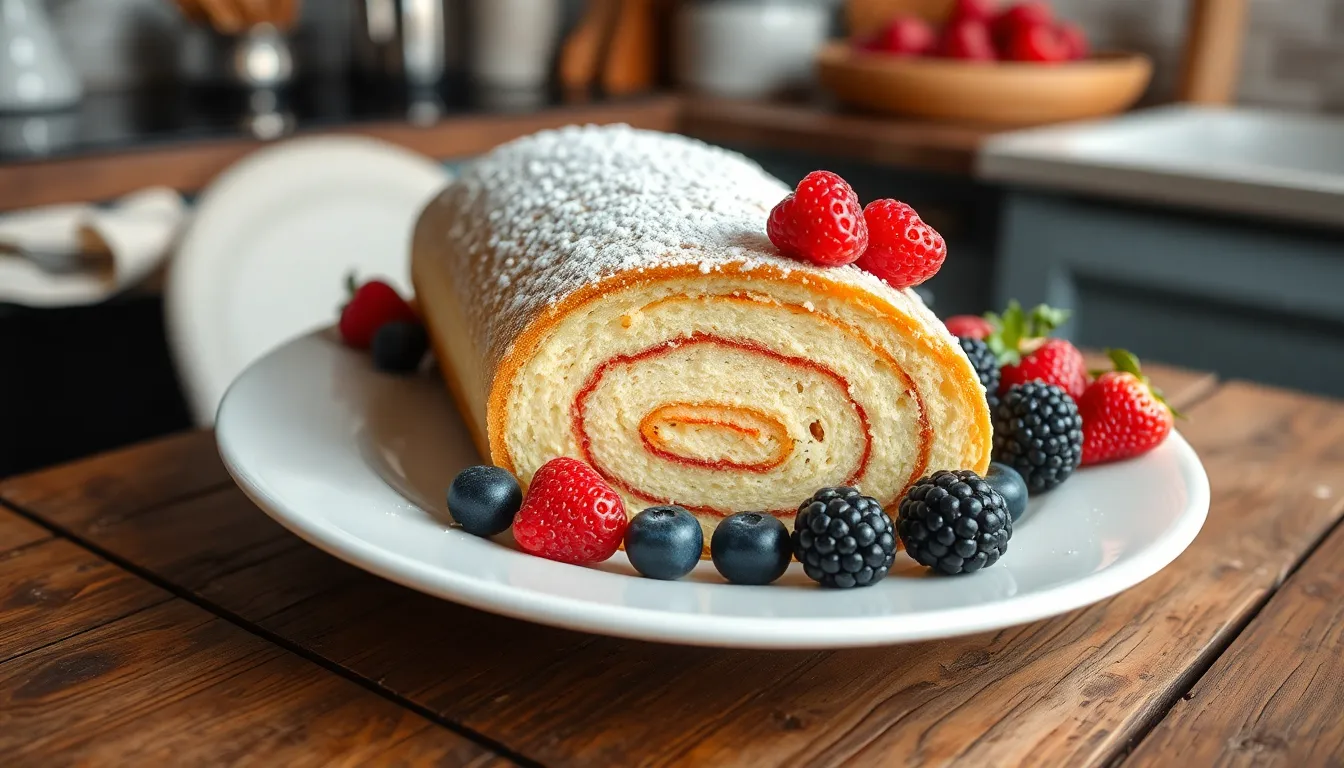
Proper storage ensures our vanilla Swiss roll cake maintains its delicate texture and fresh flavor for days after baking. We need to consider several factors when storing this elegant dessert including filling type and environmental conditions.
Refrigerated Storage
We recommend storing filled Swiss roll cake in an airtight container in the refrigerator immediately after assembly. The cake can be served directly from the fridge or allowed to return to room temperature before serving. When stored properly in the refrigerator our Swiss roll with buttercream filling stays fresh for up to 72 hours though we suggest consuming it within 24 hours for optimal taste and texture.
Room Temperature Storage
Unfilled Swiss roll cake can remain at room temperature for 1 to 2 days when stored in an airtight container. We do not recommend room temperature storage during summer months due to high temperatures and humidity that can compromise the cake’s quality. Cakes without cream fillings typically last longer than those with dairy based fillings.
Freezing Guidelines
We can freeze Swiss roll cake though it requires special preparation for best results. Pre slice the roll into individual portions and wrap each slice in parchment paper before placing in an airtight container. This method extends shelf life up to three months while maintaining texture and flavor.
| Storage Method | Duration | Temperature | Container |
|---|---|---|---|
| Refrigerated (with filling) | 24-72 hours | 35-40°F | Airtight container |
| Room temperature (no filling) | 1-2 days | 65-70°F | Airtight container |
| Frozen (pre-sliced) | 3 months | 0°F | Wrapped + airtight container |
Make Ahead Tips
Our Swiss roll cake can be prepared and filled one day before serving. Store the completed roll covered in the refrigerator overnight. Some recipes benefit from skim milk powder added to the filling which helps stabilize the texture during refrigerated storage. This technique prevents the filling from becoming too soft or separating when chilled.
Serving Suggestions
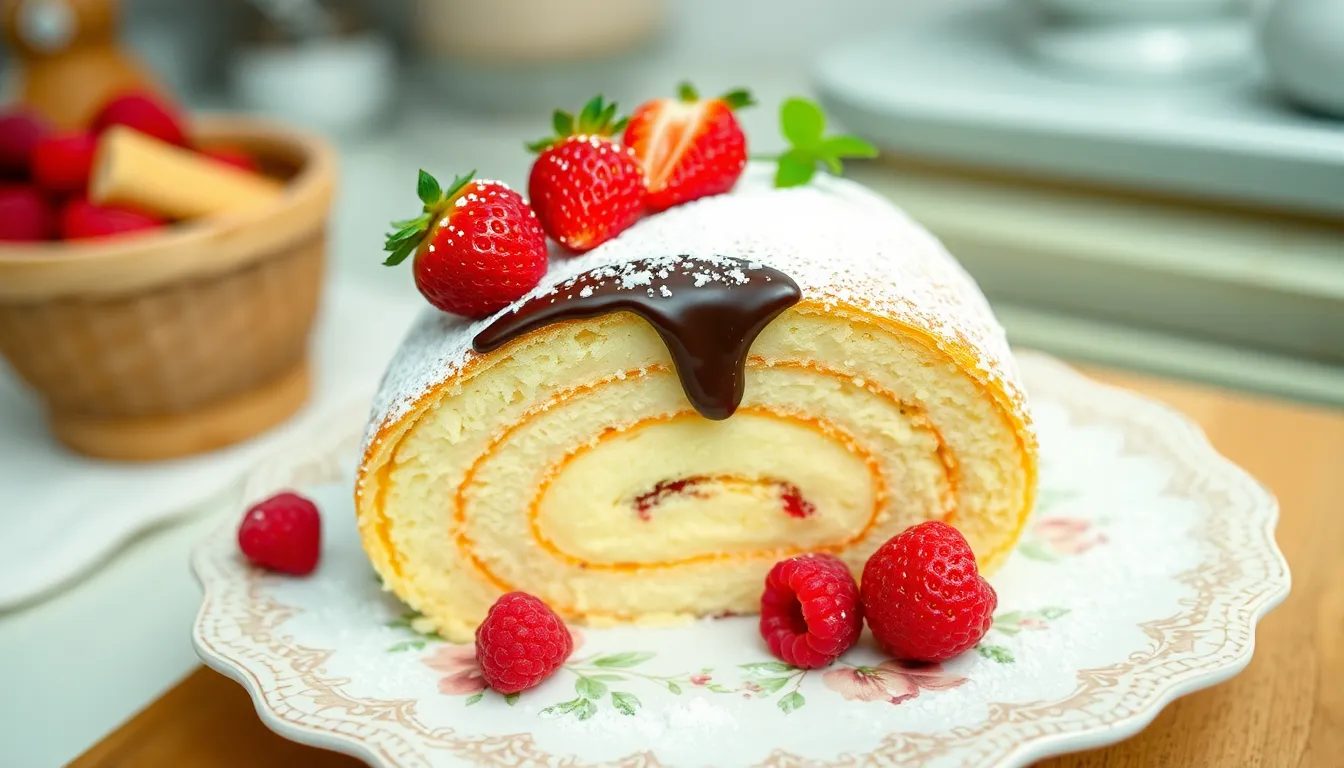
A beautifully crafted vanilla Swiss roll cake deserves presentation that matches its elegant appearance. We recommend dusting the finished cake with powdered sugar for that classic bakery look that never goes out of style. The fine white powder creates an appealing contrast against the spiral pattern visible from the ends.
Presentation Enhancement
Fresh berries transform our vanilla Swiss roll into a stunning centerpiece. Strawberries and raspberries work particularly well because their tartness balances the sweet vanilla filling. We suggest arranging them around the cake base or placing a few on top for color contrast. A light drizzle of chocolate ganache adds sophistication and creates an irresistible flavor combination.
Perfect Portioning Technique
Sharp knife work makes all the difference when serving Swiss roll cake. We always chill our cake for at least two hours before slicing to ensure clean cuts without crushing the delicate spiral. A thin sharp knife works best for this task. Each slice should be approximately 1 inch thick to showcase the beautiful swirl pattern inside.
Complementary Accompaniments
Flavored whipped cream elevates each serving beyond the ordinary. We particularly enjoy cinnamon or cardamom infused cream that adds warmth without overwhelming the vanilla notes. A small scoop of vanilla ice cream alongside each slice creates temperature contrast that guests love. Coffee or tea pairs naturally with this dessert and enhances the vanilla flavors.
Storage for Optimal Freshness
| Storage Method | Duration | Temperature |
|---|---|---|
| Refrigerated (wrapped) | Up to 3 days | 35-40°F |
| Room temperature | 1-2 days | Below 70°F |
| Frozen portions | Up to 3 months | 0°F |
We recommend storing leftover Swiss roll in the refrigerator wrapped in plastic wrap to maintain moisture and prevent the cake from absorbing other flavors. The cream filling requires refrigeration for food safety and texture preservation. Room temperature storage works only for short periods and never in hot weather conditions.
Conclusion
We’ve walked you through every step needed to create a stunning vanilla Swiss roll cake that rivals any bakery creation. From mastering the delicate sponge technique to achieving that perfect spiral with our filling we’ve covered all the essential details.
This elegant dessert proves that impressive results don’t require professional training – just patience and attention to detail. The techniques you’ve learned here will serve as your foundation for countless flavor variations.
Now it’s time to gather your ingredients roll up your sleeves and create this delightful treat. Your family and friends will be amazed by your homemade vanilla Swiss roll cake!
Frequently Asked Questions
What is a vanilla Swiss roll cake?
A vanilla Swiss roll cake is a classic European dessert featuring a light, airy sponge cake filled with creamy vanilla filling and rolled into an elegant spiral. Despite its sophisticated appearance, it’s achievable at home with proper technique and patience.
What ingredients do I need for a vanilla Swiss roll?
For the sponge: 4 large eggs, 1/2 cup granulated sugar, 1/2 cup sifted all-purpose flour, 1 teaspoon vanilla extract, 1/4 teaspoon salt, and 2 tablespoons melted butter. For filling: 1 cup heavy cream, 1/4 cup powdered sugar, 1 teaspoon vanilla, 8 oz cream cheese, and 2 tablespoons butter.
What equipment do I need to make a Swiss roll?
Essential equipment includes a jelly roll pan for the thin sponge, parchment paper to prevent sticking, an electric mixer for proper volume, large mixing bowls, and a sifter for flour preparation. A kitchen towel is also needed for the rolling technique.
What temperature should I bake the Swiss roll at?
Bake the Swiss roll at 340°F (170°C) to 360°F (180°C). The exact temperature may vary slightly, but avoid overbaking as this will make the cake dry and prone to cracking when rolled.
How do I prevent my Swiss roll from cracking?
To prevent cracking, ensure eggs are at room temperature for optimal volume, don’t overmix the flour, roll the cake while it’s still warm using a kitchen towel, and distribute batter evenly in the pan. Proper baking time is crucial to avoid dryness.
How long can I store a Swiss roll cake?
Store the filled Swiss roll in an airtight container in the refrigerator for up to 72 hours, though it’s best consumed within 24 hours. Unfilled cakes can be stored at room temperature for 1-2 days. Freeze pre-sliced portions for up to three months.
Can I make Swiss roll cake ahead of time?
Yes, you can prepare the Swiss roll cake a day in advance and store it in the refrigerator. For best results, add skim milk powder to the filling to help stabilize its texture when making ahead.
How should I serve a vanilla Swiss roll?
Dust with powdered sugar and add fresh berries for color contrast. Use a sharp knife for clean slicing and consider pairing with flavored whipped cream or ice cream. Chill the completed roll for at least two hours before serving for best results.

